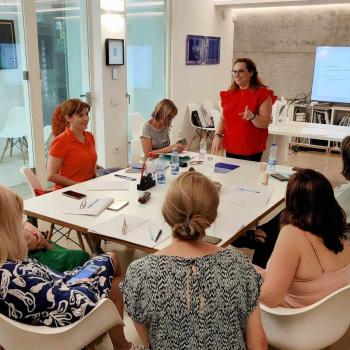
“STOP CYBERBULLYING!”
Learn about the dynamics of online cruelty and how it affects all the people involved: individuals, groups and communities; Understand better how school can activate students’ compassion to help stop cyberbullying; Apply Anti-Cyberbullying Toolkit and additional resources to ensure that teachers and schools are prepared to avoid this pitfall of our digital world;Prepare anti-cyberbullying lessons
Description
MONDAY (Day 1) Module 1: Welcome and registration; Ice-breaking and Warm Ups; Team-building session; Introduction: Cyberbullying: Crossing the Line: What is Cyberbullying and why it is so dangerous: Understanding Cyberbullying: Cyberbullying vs. traditional bullying and why is cyberbullying becoming a major issue? Types of Bullies and Why Bullying Happens; Impacts of Cyberbullying; How and why young people use the Internet and social networking; Ways to establish and maintain boundaries on Internet use and content accessed by young people
TUESDAY (Day 2) Module 2: Cyberbullying Prevention Guidelines: Building a Safe and Supportive Online Environment: Recognizing the warning signs; Staying Safe in and outside classroom: Action Plan; Beat-the-CyberBully Checklist; Managing Classrooms to Prevent Bullying: Classroom Meetings; Supporting Kids Who are Bullied; Supporting Bystanders Who Witness Bullying;Stop Bullying on the Spot; Using drama techniques
WEDNESDAY (Day 3) Module 3: Outdoor activity with a training task: “Treasure Hunt”: In the shoes of our learners
THURSDAY (Day 4) Module 4: Workshop: Teen Cyberbullying: Types and Victims, and What to Do: How to Recognize Aggressive Behavior; How to Spot Passive-aggressive Behavior; Aggression on the Internet: Be Effective, Be Assertive; Social Media, Apps and Sites Commonly Used by Children and Teens; Cyberbullying and Online Gaming; Important Rules of Peer Negotiations; School, Teachers & Parents UNITED vs. Bullying; Report Cyberbullying to Online Service Providers, to Law Enforcement, to Schools.
FRIDAY (Day 5) Module 5: Workshop: Understand the risks of (cyber)bullying for both victims and perpetrators, and witnesses; Effective Anti-Cyberbullying Actions and Programs; Cyberbullying and school climate
SATURDAY (Day 6) Module 6: Preventing and Addressing Cyberbullying: More Empathy, More Compassion, More Respect
SUNDAY (Day 7) Module 7: Feedback, course evaluation, delivery of certificates
Learning objectives
Learn strategies to detect, avoid, and tackle cyberbullying; Raise awareness of the warning signs that you/someone else is being bullied, so that you can take the necessary action; Learn about the risks of bullying and cyberbullying; Develop the idea that the cyberbullying is much easier to prevent it before it leads to a real disaster; Advise on how to deal with the perpetrators of violence and its victims, how to involve people who can help in this situation, i.e. parents, educators and peers; Understand how and why young people use the Internet and social media and show the risks of using the internet unsafely; Raise awareness of bullying and to learn how to bring individuals, organisations and schools together to take a stand against cyberbullying; Give participants a confidence to challenge cyberbullying; Discuss positive and negative aspects of interacting with others online; Teach how to respect others and to take a stand against bullying of all kinds; Raise understanding about the motives and the nature of cybercommunications, as well as the demographic and profile of a cyberbully differ from their offline counterpart; Explore ways to handle cyberbullying and how to respond in the face of upsetting language online; Learn the difference between being a passive bystander versus an upstander in cyberbullying situations and to identify concrete solutions for dealing with cyberbullying situations; Learn how to apply effective methods for working with the students and the parents to stop and remedy cyberbullying situations; Be educated on cyberethics and the law; Prevent and deal with the consequences of cyberbullying; Address ways kids and teens can become inadvertent cyberbullies, how to be accountable for their actions and not to stand by and allow bullying (in any form) to be acceptable; to teach them not to ignore the pain of others; Change the culture of how we prevent and respond to cyberbullying; Understand all the facets of cyberbullying.
Methodology & assessment
Certification details
At the end of the course, each participant will be awarded a Certificate of Attendance along with Europass Mobility.
Our certificates are in line with the Erasmus Quality Standards and so include the course's title, short description of its learning outcomes (if requested), dates, venue, the name of the course provider and the course director, number of training hours.
We support participants in every step of certification and validation of learning outcomes with specific focus on European instruments and Erasmus+ requirements such as Learning Agreement, Quality Commitment and Europass mobility.
Pricing, packages and other information
-
Price:560Euro
Additional information
-
Language:English
-
Target audience ISCED:Primary education (ISCED 1)Lower secondary education (ISCED 2)Upper secondary education (ISCED 3)
-
Target audience type:TeacherHead Teacher / PrincipalPedagogical Adviser
-
Learning time:25 hours or more
Upcoming sessions
Past sessions
More courses by this organiser

EMERGING MODELS IN EDUCATION: FLEXIBILITY, INNOVATION, COLLABORATION

“MENTORING SKILLS FOR CAREER DEVELOPMENT”


